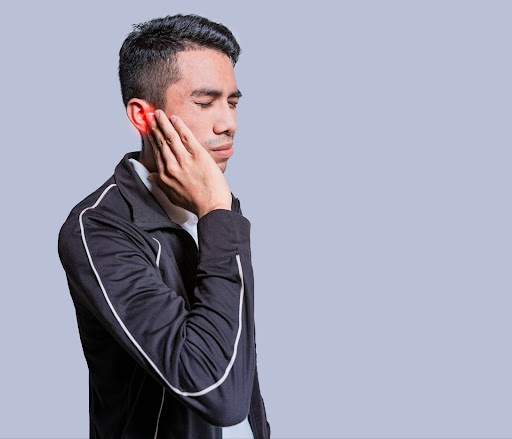Does Gabapentin Help with Sciatica?
Sciatica can cause sharp pain that shoots down your leg, making simple tasks hard. Many people wonder if gabapentin, a common medication, can ease this pain. This article [...]
Read More
Medically reviewed by Abhijit Bhattacharyya | MD, PhD, MBA, Tufts University School of Medicine - Miami, Florida on June 16th, 2025.
Headaches can manifest in various forms, and one of the more perplexing types is the headache behind the ear. This specific location can indicate a range of underlying causes, from tension and stress to more serious medical conditions.
Understanding these causes is essential for effective treatment and management. Doctronic helps by providing quick, personalized insights for better health decisions.
 Understanding Headaches
Understanding HeadachesHeadaches are a common ailment that many individuals experience. According to studies, more than 50% of the global adult population has experienced a headache in the past year. They can vary significantly in intensity, duration, and location. The pain may be localized to one area, such as behind the ear, or it may radiate throughout the head.
Identifying the type of headache is crucial for determining its cause. In addition to the physical discomfort, headaches can also impact daily activities, productivity, and overall quality of life, making it essential to understand their underlying mechanisms.
Headaches are generally categorized into two main types: primary and secondary headaches. Other medical conditions do not cause primary headaches, while secondary headaches result from underlying health issues.
Understanding these categories can help individuals recognize patterns in their headache occurrences and seek appropriate treatment.
Primary Headaches: These include tension headaches, migraines, and cluster headaches. They are often triggered by stress, dehydration, or environmental factors. Tension headaches, for instance, are frequently associated with muscle tightness in the neck and shoulders, while migraines may be linked to hormonal changes or certain foods.
Secondary Headaches: These headaches are symptoms of other health problems, such as infections, head injuries, or neurological disorders. Conditions like sinusitis or meningitis can lead to severe headaches that require immediate medical attention, highlighting the importance of understanding the context in which a headache occurs.
The symptoms accompanying a headache behind the ear can vary based on its cause. Common symptoms include:
Pain localized to the area behind the ear
Throbbing or sharp sensations
Accompanying symptoms such as nausea or sensitivity to light
In addition to these symptoms, individuals may experience tension in the jaw or neck, which can exacerbate the pain. It's also worth noting that some headaches can be accompanied by visual disturbances, such as an aura, which can precede a migraine.
Keeping a headache diary can be beneficial for tracking triggers and symptoms. It allows individuals to identify patterns and discuss them with healthcare providers for more tailored treatment options.
Moreover, lifestyle factors play a significant role in headache management. Regular exercise, adequate hydration, and a balanced diet can help reduce the frequency and severity of headaches.
Stress management techniques, such as mindfulness and relaxation exercises, are also effective in alleviating tension headaches. Understanding the interplay between physical health, emotional well-being, and headache occurrence can empower individuals to take proactive steps toward prevention and management.
Several factors can contribute to the onset of a headache behind the ear. Understanding these causes can help individuals seek appropriate treatment and alleviate discomfort.
Tension headaches are among the most common types of headaches and can often cause pain that radiates to various areas, including behind the ear. Stressful situations, poor posture, and muscle tension can exacerbate these headaches.
Muscle tightness in the neck and shoulders can lead to referred pain, which may be felt behind the ear. Techniques such as relaxation exercises, stretching, and proper ergonomics can help reduce tension and prevent these headaches.
Additionally, mindfulness practices such as yoga and meditation can be beneficial in managing stress levels, allowing individuals to cultivate a greater sense of calm and control over their physical responses to stressors.
Sinusitis, or inflammation of the sinuses, can also lead to headaches behind the ears. When the sinuses become blocked or infected, pressure can build up, causing pain that may radiate to the area around the ear.
Symptoms of sinusitis may include nasal congestion, facial pain, and fever. Treatment often involves decongestants, nasal sprays, or, in some cases, antibiotics.
In addition to these treatments, home remedies such as steam inhalation, warm compresses, and staying hydrated can also provide relief by helping to clear the sinuses and reduce pressure. Understanding the triggers for sinusitis, such as allergens or irritants, can also aid in prevention and management.
Ear infections can cause significant discomfort and may lead to headaches behind the ear. The inflammation and pressure from the infection can radiate pain to surrounding areas, including the head.
Symptoms of an ear infection may include ear pain, fever, and difficulty hearing. Prompt medical attention is essential to manage the infection and alleviate associated headaches.
In some cases, recurrent ear infections may indicate underlying issues, such as allergies or anatomical abnormalities, that should be evaluated.
Furthermore, preventive measures, such as avoiding exposure to tobacco smoke and ensuring proper ear hygiene, can help reduce the risk of developing ear infections in the first place.
While the aforementioned causes are common, there are also less frequent conditions that can lead to headaches behind the ear. These may require more specialized treatment and diagnosis.
Cervicogenic headaches originate from issues in the cervical spine or neck. Conditions such as herniated discs, arthritis, or muscle strain can lead to pain that radiates to the head and may be felt behind the ear.
Physical therapy, chiropractic care, and pain management strategies can be effective in treating cervicogenic headaches.
In addition to conventional treatments, alternative therapies such as acupuncture and massage therapy may also provide relief for those suffering from cervicogenic headaches.
These approaches focus on alleviating muscle tension and improving blood flow to the affected areas, which can help reduce the frequency and intensity of headaches. Furthermore, lifestyle modifications, including ergonomic adjustments at work and regular exercise, can play a significant role in preventing the recurrence of these headaches.
Trigeminal neuralgia is a chronic pain condition that affects the trigeminal nerve, which carries sensation from the face to the brain. This condition can cause severe, sharp pain that may be felt behind the ear.
Triggers for trigeminal neuralgia can include touch, chewing, or even a breeze. Treatment options often involve medications, nerve blocks, or, in some cases, surgery.
Patients may also benefit from lifestyle changes that minimize triggers. For instance, maintaining a consistent eating schedule and avoiding overly hot or cold foods can help manage symptoms.
Additionally, stress management techniques, such as mindfulness and relaxation exercises, can be beneficial, as stress is known to exacerbate pain conditions.
Support groups and counseling may also provide emotional support and coping strategies for those living with the challenges of trigeminal neuralgia, fostering a sense of community and understanding among individuals facing similar struggles.
 Diagnosing the cause of a headache behind the ear typically involves a thorough medical history and physical examination. Healthcare providers may also recommend imaging studies, such as MRI or CT scans, to rule out serious conditions.
Diagnosing the cause of a headache behind the ear typically involves a thorough medical history and physical examination. Healthcare providers may also recommend imaging studies, such as MRI or CT scans, to rule out serious conditions.
In addition to these methods, a detailed assessment of headache patterns, triggers, and associated symptoms can provide valuable insights.
Keeping a headache diary, where patients log the frequency, intensity, and duration of their headaches, can be instrumental in identifying underlying causes and tailoring treatment plans.
While many headaches can be managed at home, certain symptoms warrant immediate medical attention. These include:
Severe headache that comes on suddenly
Headache accompanied by confusion or difficulty speaking
Fever or stiff neck
Pain that worsens or does not improve with over-the-counter medications
It is crucial to be aware of other concerning signs as well, such as vision changes, persistent vomiting, or headaches following a head injury.
These symptoms may indicate more serious conditions, such as meningitis or a brain aneurysm, which require urgent evaluation and intervention. Understanding these red flags can empower individuals to seek timely care and potentially prevent complications. Doctronic.ai, your AI doctor, will explain everything in a way that makes sense to you so you can always be informed about your health.
Treatment for headaches behind the ear varies based on the underlying cause. Common approaches include:
Over-the-Counter Medications: Nonsteroidal anti-inflammatory drugs (NSAIDs) such as ibuprofen or acetaminophen can help relieve pain.
Prescription Medications: For more severe headaches, doctors may prescribe stronger pain relievers or medications specifically for migraines.
Physical Therapy: This can be beneficial for tension headaches or cervicogenic headaches, focusing on strengthening and stretching neck muscles.
Alternative Therapies: Acupuncture, massage therapy, and relaxation techniques may also provide relief for some individuals.
In addition to these conventional treatments, lifestyle modifications can play a significant role in managing headaches.
Staying hydrated, maintaining a regular sleep schedule, and practicing stress-reduction techniques such as yoga or meditation can help minimize headache frequency and intensity.
Furthermore, identifying and avoiding specific triggers, such as certain foods, environmental factors, or stressors, can empower individuals to take control of their headache management and improve their overall quality of life.
Preventing headaches behind the ear involves adopting a proactive approach to health and wellness. Here are some strategies to consider:
Making certain lifestyle changes can significantly reduce the frequency and severity of headaches. These may include:
Hydration: Staying well-hydrated can help prevent dehydration-related headaches.
Stress Management: Techniques such as yoga, meditation, or deep-breathing exercises can help manage stress levels.
Regular Exercise: Engaging in regular physical activity can improve overall health and reduce the likelihood of tension headaches.
In addition to these strategies, maintaining a balanced diet rich in vitamins and minerals can also play a crucial role in headache prevention. Foods high in magnesium, such as leafy greens, nuts, and whole grains, have been shown to help reduce the frequency of headaches.
Additionally, incorporating omega-3 fatty acids found in fish like salmon and walnuts may provide anti-inflammatory benefits that can alleviate headache symptoms.
It’s essential to recognize any food triggers that might contribute to headaches, such as aged cheeses, processed meats, or caffeine, and adjust your diet accordingly.
Maintaining good posture and ergonomic practices, especially for those who work at desks, can help alleviate tension in the neck and shoulders. Simple adjustments to seating, computer screens, and workstations can make a significant difference.
For instance, ensuring that your computer monitor is at eye level can prevent neck strain, while using a chair that supports your lower back can enhance comfort during long hours of work.
Furthermore, taking regular breaks to stretch and move around can help relieve built-up tension. Implementing the 20-20-20 rule, looking at something 20 feet away for 20 seconds every 20 minutes, can also reduce eye strain and prevent headaches related to prolonged screen time.
Incorporating these ergonomic practices not only promotes a healthier workspace but also encourages greater productivity and focus throughout the day.
Headaches behind the ears can arise from various causes, from tension and stress to underlying medical conditions. Understanding these causes is crucial for effective management and treatment. By recognizing symptoms, seeking medical attention when needed, and taking preventive steps, individuals can better manage discomfort and improve their quality of life. Doctronic offers AI-powered support to help track symptoms, identify patterns, and guide smarter health decisions.
Sciatica can cause sharp pain that shoots down your leg, making simple tasks hard. Many people wonder if gabapentin, a common medication, can ease this pain. This article [...]
Read MoreBack pain is one of the most common health complaints, affecting millions of people worldwide. If you have back pain, you might have heard about gabapentin as a possible [...]
Read MoreIf you take gabapentin, you might wonder if it will show up on a drug test. This question matters for many people, whether it’s for work, sports, or legal reasons. Gabapentin [...]
Read More